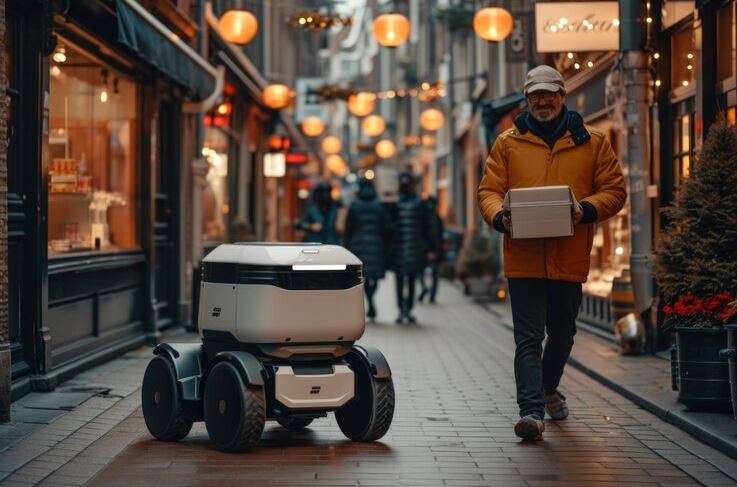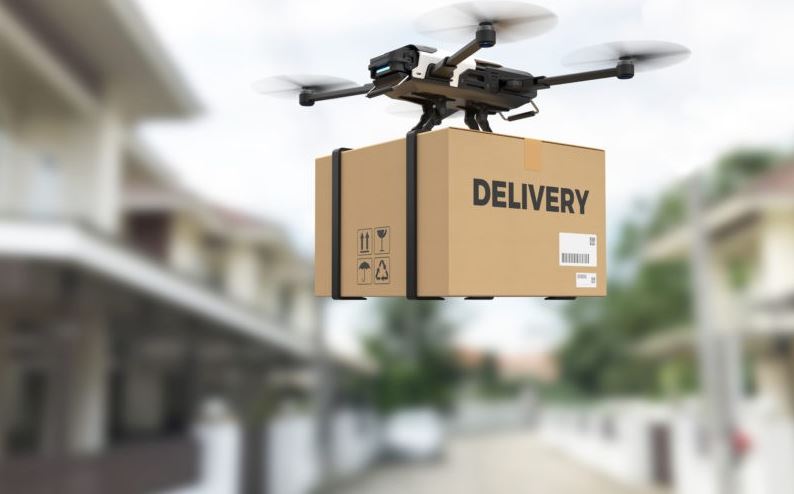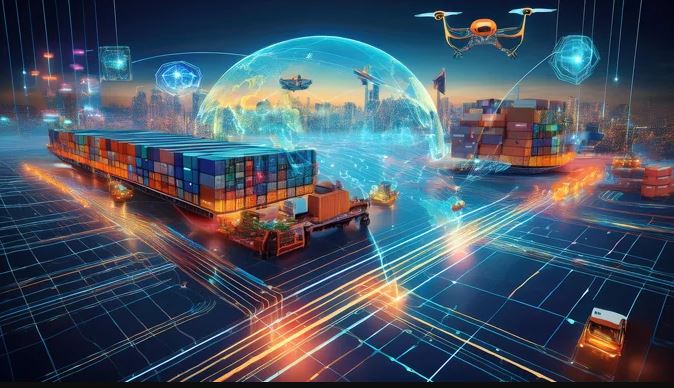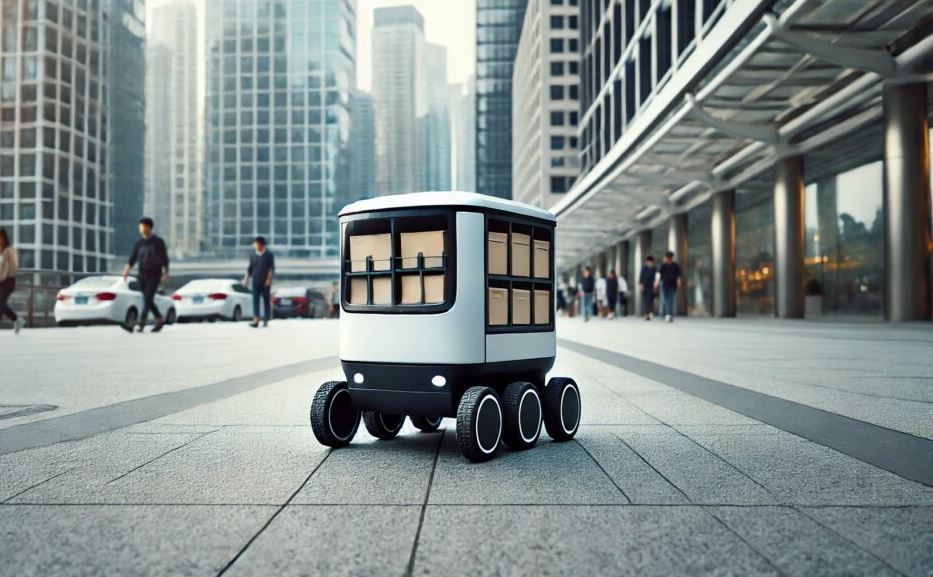The development of the robot delivery system has forced a change in last-mile delivery systems. Thanks to the use of modern navigation and sensor technologies and AI, robotic delivery startups are creating the proper conditions for increasing the speed of delivery services, minimizing possible risks, and making the delivery process more efficient. This advanced technology aspires to redefine the movement of goods, and in particular, provide timely and affordable delivery to customers.
In this article, regarding the topic of robotic delivery, we will be analyzing those aspects such as the key elements, advantages, and disadvantages, and potential development in the future. Including robotics in logistics is a move towards changing the supply chain and solving the problems of last-mile delivery.
How Robotic Delivery Works: Advanced Technology and Autonomy
Navigation Systems and Artificial Intelligence
Delivery robots use sophisticated ways of movement and AI capabilities for safe and efficient movement and to alter routes in real time. Both Ottobots developed by Ottonomy and robots developed by Starship technologies use GPS and Lidar (Light Detection and Ranging) mapping techniques in creating maps of their environment. These technologies assist them in managing complicated city environments and remain responsive to every condition to deliver the products safely and on time.
Sharp Sensors and Cameras
Most delivery robots are built with aspects such as pedestrian, street furniture, and vehicle detection in real-time, thereby avoiding accidents. Technologies include Lidar whereby the robot acquires distance measurements, and upon achieving this, becomes capable of moving through congested areas and reaching the clients expeditiously. Machine vision also enhances object recognition, allowing for smooth delivery in crowded spaces.

Secure Package Handling
Robots are designed to securely transport packages, often featuring code-locked compartments for recipient verification. When the delivery robot gets to the house of the recipient there may be a need for a code to open and take the parcel. First, this feature provides extra measures for the safety of the package, second, no one can tamper with the package, hence consumers are assured of the package.
Benefits of Robotic Delivery
Reduced Delivery Times and Costs
Robotic delivery significantly reduces delivery times and operational costs. By operating from micro-fulfillment centers near high-demand areas, robots can quickly collect packages and deliver them within a short radius. This proximity minimizes costs associated with traditional delivery methods and enhances efficiency in last-mile delivery.
Enhanced Consumer Experience
Delivery robots integrate with smart home systems, offering real-time delivery updates. Recipients can track their package’s journey, estimated arrival time, and final drop-off status. This transparency adds an extra layer of convenience, as some robots can deliver to secure areas like garages or smart lockers, providing added security and flexibility for recipients.
Eco-Friendly Solution
E-commerce aids environmental protection because it eliminates the need to use fossil fuel-powered delivery cars. Battery operation helps reduce emissions another important factor in areas where pollution standards are normally high. As environmental concerns grow, robotic delivery startups continue to work on enhancing battery life, recharging solutions, and eco-friendly designs to minimize their carbon footprint further.
Overcoming Challenges in Robotic Delivery
High Maintenance and Operational Costs
Maintenance of high-tech robots involves significant expenses, from regular servicing to component replacement. Costs are at the moment a limiting factor and this particularly affects small businesses compelled to operate at a loss for market share. But, with the constant improvement of the technology and the factors of economies of scale, these costs are also expected to decline in the future, thus incorporating the robotic delivery service into the supply chain becomes less expensive for the different manufacturers.
Regulatory and Technical Barriers
Compliance with local regulations is a considerable challenge, as different regions have distinct rules governing robotic operations. Companies often need to work closely with authorities to meet safety and regulatory standards, which may vary widely. Additionally, infrastructure limitations in some areas restrict robot accessibility, as not all streets and sidewalks are suited for autonomous vehicles.

Safety and Public Acceptance
Consumer acceptance is thus the key to the success of the robotic delivery system in the long run. From the safety point of view, only some of the features like sensors and cameras installed with robots must not cause any accidents. Businesses have also embarked on public sensitization to enlighten the population on the convenience and precaution measures with robotic delivery.
Notable Developments in Robotic Delivery
Starship Technologies Expands Global Operations
Starship Technologies has made strides in robotic delivery, recently raising $90 million for global expansion. With over six million deliveries already completed, the company aims to improve AI capabilities, develop wireless charging systems, and make its robots more efficient and sustainable.
Uber Eats and Cartken’s Collaboration in Japan
In Japan, Uber Eats has partnered with Cartken to introduce sidewalk robots for food delivery. These robots navigate sidewalks, interact with customers, and offer a unique, autonomous delivery experience. This partnership exemplifies how robotics are becoming a key player in the food delivery industry and demonstrates the potential for future expansions.
Japan’s Robotic Revolution
Japan has embraced robotic delivery through various innovations, including Panasonic’s “Hakobo”, a robot designed for autonomous delivery. These robots navigate complex environments and offer a variety of services, from package deliveries to healthcare support. This aligns with Japan’s broader strategy to integrate robotics into everyday life, from logistics to household assistance.
Future Trends in Robotic Delivery
Increased Autonomy and Personalization
As technology progresses, robotic delivery systems are expected to become more autonomous and customizable. The consumers could soon have a chance to define more precise delivery times, and drop-off points, and receive relevant notifications, making the experience much more pleasurable. As with AI, robots will become far more identified and will expand on personal processes.
Expansion into New Sectors: Healthcare and Retail
Robotic delivery’s potential extends beyond packages and food, as healthcare and retail industries begin to explore its applications. In preferred drop-off locations healthcare, robots could deliver prescription medications and other essential supplies, supporting contactless services in hospitals and residential areas. In retail, robotic delivery may streamline product distribution, ensuring faster and more reliable service.

Evolution of Micro-Fulfillment Centers
The emergence of micro-fulfillment centers is expected to increase to support robot applications in last-mile logistics delivery. It is for this reason that these centers are intended to be used for automated inventory storage and packaging dispatch. With the continuing advancement in technology and the subsequent reduced costs of robotics, business organizations will begin establishing micro-fulfillment centers to cater to consumer proximity, and therefore reduce delivery time and cost.
Conclusion
The extremely fast functioning of robotic delivery identifies the importance of technology in present logistic processes. Commercial robotic delivery startups have gained importance among companies around the globe because of the effectiveness, convenience, and positive environmental impact they have. This paper analyzes how robotic delivery differs from traditional methods in the sense of delivery distance and time, customer service improvement, and environmental impact.
In the future, the continuous improvement of AI, increasing innovations of sensors, and dynamic legislation will also shape the next developments of robotic delivery. While challenges persist, the continuous improvements in robotic delivery promise a future where autonomous delivery becomes a regular part of daily life, revolutionizing tech-enabled logistics for both consumers and businesses.
FAQs
Delivery robots use GPS, Lidar, and sensors to detect obstacles precisely.
Yes, many robots integrate with smart homes for secure package deliveries.
High costs, regulatory barriers, and public acceptance remain primary challenges
Yes, as electric-powered robots, they reduce carbon emissions significantly.
Robotic delivery offers faster service, transparency, and added delivery security.
